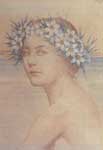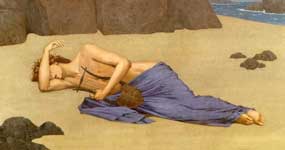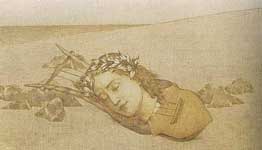Paintings

Josephin Peladan

Narcisse

Orpheus' Lament

The Lyre of Orpheus

The Siren

Thinking
Alexandre Séon (1855, Chazelles-sur-Lyon, Loire - 1917) was a French Symbolist artist, illustrator and decorator. Séon studied at the Beaux-Arts of Lyon and Paris, becoming a student of Puvis de Chavannes in 1891, with whom he later collaborated.[1] He was closely associated with Joséphin Péladan and his Salon de la Rose-Croix, and designed the frontispiece for Péladan's 1891 novel l'Androgyne.[2]
Born into a merchant family, Alexandre Seon has a happy childhood and a rural culture, its legends, communicates the taste of the marvelous. Student at the Academy of Fine Arts in Lyon, he also decorative arts and ornamental design for the textile industry in Lyon.
In 1877 he went to Paris and took classes at Henri Lehmann, he met Seurat1, Alphonse Osbert, Edmond Aman-Jean, but Pierre Puvis de Chavannes, which will be the student and assistant for ten years and whose influence will be decisive. He exhibited from 1879 in the various rooms and became a leading figure of the symbolism. Around 1890, however, his works reflect the influence of Seurat which he adapted the technique with the help of the critic and theorist Alhponse Germain to reach a neo-impressionist who can convey his idealistic aspirations.
Alphonse Germain2 in Art Criticism and defines it as "symbolist-idéiste" Emile Verhaeren is the "land of light" at their show at Le Barc de Boutteville in 1892.
In 1892, Seon helped found the Rosicrucians which will be a faithful. It will leave a picture of Josephin Peladan, said Sar Peladan in "Nabi of ideality." Unscrupulous art teacher at the City of Paris from 1881 to 1915, he will receive some orders and official, despite his signs to the City of Courbevoie, ambition decorator will not be favored. He has written scholarly material on the "perspective of your division" and "the symbolism of line and color". Deherme friend of George (founder of the popular universities), it creates cheap lithographs, organizes visits to the Louvre for workers and advocates for the Hall of the People.
It illustrates the esoteric works, carries the symbols of the Rosicrucians and the frontispieces of Josephin Peladan works. Poetic inspiration, reverence pure forms, theoretical concerns and social concerns come together at this complex work and idéaliste3.
Works
Lamentations of Orpheus (1896), oil on canvas, 73 x 116 cm Paris, Musée d'Orsay.
Portrait of Sar Peladan, Lyon, Museum of Fine Arts.
The Star, Private Collection.
Returning home (circa 1915), oil on canvas, 93x140 cm, Museum of Modern Art in Saint-Etienne Métropole
Orpheus, oil on wood, 45,5 x30, 5 cm, Museum of Modern Art in Saint-Etienne Métropole
Muse, oil on canvas, 24.2 x 21 cm, Museum of Modern Art in Saint-Etienne Métropole
Notes and references
↑ Seon will be the only painter Seurat would still go to the end of his life and around 1890, his works reflect his influence, he adapts the technique with the help of the critic and theorist Alphonse Germain to reach a neo- Impressionism, which can transmit his idealistic aspirations. See Jean-David Jumeau-Lafond, "Neo-Impressionism idealistic Alexandre Seon" in From Romanticism to Art Deco, mixtures offered to Jean-Paul Bouillon, Rennes, PUR, 2011.
↑ Alphose Germain, evoked the "fugitive tints where undecided precise joins
↑ Jean-David Jumeau-Lafond, The Painters of the Soul, Symbolism of idealism in France, 1999; Painters of the Soul, Symbolism in France, 2007
Retrieved from "http://en.wikipedia.org/ ", Text is available under the Creative Commons Attribution-ShareAlike License
Art Books
